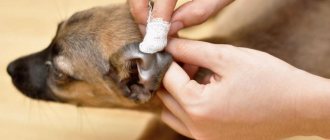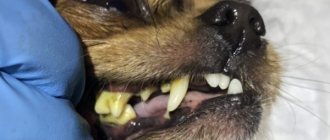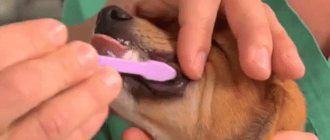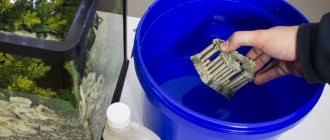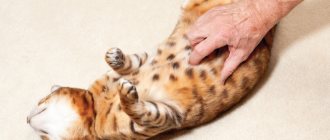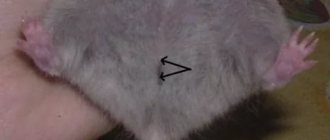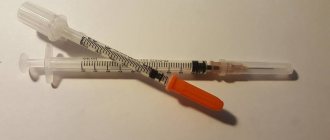Tips to help you brush your cat's teeth at home.
Cats occupy the first positions in the lists of the most beloved pets. Agree, it’s nice when this purring face comes to you and expresses its feelings in the cutest way. However, cats, like any other animal in principle, bring not only joy and tenderness, they also cause a lot of trouble. After all, any living creature needs constant care, moreover, proper care must be provided and exactly the kind that each specific animal needs. Today we will talk about oral hygiene in cats and figure out how to adhere to it.
Do cats and kittens need to brush their teeth?
Before answering the question: “Do cats need to brush their teeth?” Let's talk a little about dental diseases of these animals and their causes.
The oral cavity of cats is not much different from the human oral cavity.
- A person, unlike an animal, can independently take care of himself and his hygiene, moreover, he can do this to the required extent
- The animal cannot brush its teeth or seek dental care on its own. Despite this, cats' teeth are no less susceptible to disease than human teeth.
- It must be said that there are several factors that, one way or another, influence the development of dental diseases in pets:
- Insufficient care of the animal and its teeth
- Food the animal eats
- Previous infectious diseases
- Misaligned teeth
- The presence of harmful bacteria that negatively affect the microflora of the oral cavity
- Predisposition
- Insufficient care of the animal and its teeth
Brushing a cat's teeth
Now let's pay a little attention to those diseases that appear in cats precisely because of improper and insufficient oral care:
- Plaque. Plaque is the first enemy of cat teeth. What is a raid? Plaque is food debris, saliva and, of course, bacteria. The plaque can be gray, white or yellow. Why is it so important to ensure that your animal’s teeth are free of plaque? It's very simple - the formation of plaque causes other, more serious problems with teeth
- Tartar. Tartar is precisely the more serious problem that arises as a result of ignoring plaque. The plaque becomes hard and forms stone deposits in which thousands of bacteria happily live and multiply. With such an illness, seeking help from a veterinarian is mandatory, because ignoring this problem will at least lead to tooth loss
- Caries. This disease affects not only people, but also animals. In simple terms, caries is tooth decay.
- Osteomyelitis of teeth. The cause of this serious illness is untreated caries or an infection in the oral cavity. The disease manifests itself as suppuration on the gums
The list of dental diseases in cats can be continued for quite a long time, but there is no point in it. So, what, in fact, was all the above information brought to? And besides, the cause of all these diseases, as a rule, is improper oral hygiene.
Is it worth answering the question now: “Do cats need to brush their teeth?” Remember, oral hygiene should be carried out for almost all pets and cats top this list.
When does a cat need a dentist?
Most cats experience dental problems at some point. And here's how you can help them.
Over the course of its life, a cat grows two rows of teeth. The first set consists of 26 teeth, otherwise known as baby teeth. They begin to appear when the kitten is about four weeks old, and by six weeks or so, the full set is present. By the time a kitten is about six months old, the baby teeth will have fallen out and will be replaced by 30 permanent teeth - specially designed by Mother Nature for catching prey, tearing it apart and chewing it. They are also useful for self-defense.
The term "permanent", however, is not entirely accurate, as a significant portion of the adult cat population will eventually lose one or more of their teeth due to injury or disease. According to veterinary dentists, only about 10 percent of cats will be able to live their lives without experiencing any dental problems. And in many cases, the problem can only be resolved by removing the affected tooth, if there are not very many of them.
Nature and nurture
To some extent, dentists say, genetics plays a role in determining which cats are more susceptible to dental disease, pointing out that certain purebred breeds, such as Abyssinians, Siamese, Maine Coons, Persians and Somalis, tend to be the most susceptible. risk. But the main cause of dental problems can be traced to the diet of modern cats.
The cat is a carnivore. His teeth must be strong and clean when he chews the meat and bones of birds, rodents and other predators. Today the cat lives mainly on a diet of porridge, which we feed it. And by doing so, we are unintentionally creating serious dental problems for our cats.
Common dental diseases in cats
Four types of feline dental disease account for the vast majority of problems for which the removal of one or more teeth may be the only cure:
Periodontitis is the most common disease, affecting an estimated 85 percent of cats over six years of age. With this disease, layers of plaque accumulate and harden on the surface of the tooth. Bacterial toxins and enzymes from plaque eventually cause an inflammatory reaction in the gums (gums), which, if left untreated, leads to severe gum inflammation (gingivitis). In cats, advanced periodontal disease can rapidly progress to an end stage for which tooth extraction is the only reasonable treatment option.
Feline odontoclastic resorptive lesions (FORL) are another relatively common dental disease, affecting approximately 50% of cats. This disease is characterized by lesions caused by plaque that begins in the bone tissue (dentine) just below the enamel. Due to an inadequate immune system response, the tissue is unable to repair itself and damage can progress rapidly and damage the tooth and its root irreparably. According to Dr. Carmichael, any tooth in which the FORL has expanded to the point where the damage poses a threat to the pulp chamber should be removed.
Feline gingivitis/stomatitis syndrome (FGS) is a relatively rare disease, affecting approximately one in 100 cats, most commonly among those with feline leukemia virus (FeLV), feline immunodeficiency virus (FIV), or other viral, nutritional, or hormonal diseases. Although antibiotics and steroid therapy may be helpful in some cases, removal of most or all teeth may be the only treatment option.
Tooth fracture can occur as a result of trauma or, less commonly, as a result of chewing. Inaction, dentists warn, leaves a broken tooth painful and can lead to infection. The extraction thus serves the purposes of relieving the affected cat's pain and preventing infection.
Signs that a cat is suffering from dental problems, says Dr. Carmichael, include bad breath, red and swollen gums, the cat manipulating the cat's paw in the mouth, and refusing solid food. But cats are unlikely to show that they are in pain: cats are descended from wild animals, and it is very deep in them that if they show weakness, they themselves can become prey.
Problem solving
The only way to “really find out what's going on” in a cat's mouth, veterinary dentists assure, is to examine the animal's teeth under general anesthesia and, if necessary, take an x-ray. The cat is usually sedated for as long as necessary for teeth cleaning, examination, and treatment as needed. If extraction is necessary, the procedure may take 45 minutes to an hour.
Surgical removal
If the tooth is not so damaged that it is ready to fall out, dentists remove the tooth through surgical removal. “We never just pull out a tooth,” they explain. “Rather, we lift the gum tissue from the outside of the tooth and use a powerful, water-cooled drill to remove some of the bone tissue that holds the tooth in place in the mouth. We then use special instruments to remove the tooth and stitch the gums back together with absorbable suture material. - Any licensed veterinarian can clean, examine and remove teeth.
Shortly after extraction, he says, the cat wakes up and goes home with a few days' supply of painkillers. One thing we can guarantee is that your cat will never grieve over a tooth that has been removed. She will feel better, eat better, and live better overall without him.
How to properly brush your cat’s teeth at home: tips
People understand very well the importance of this procedure, so, as a rule, even a small child does not have any difficulties when brushing their teeth. However, animals are not given the opportunity to understand that brushing their teeth is a necessary procedure for them.
Often cats do not like to brush their teeth and, of course, try in every possible way to prevent their owner from doing so. That is why it is very important to know how to clean the animal’s mouth correctly and painlessly for him.
So, let's look at how to properly perform dental hygiene on a cat:
- Of course, you should start by placing the cat in a position that is comfortable for you. This does not mean that you can put him on his back and press him to the sofa, no. You need to take the pet either with its face towards you or away from you, depending on how comfortable it is for you. In the process of brushing its teeth, the animal will, of course, struggle and scratch, so outside help will be very helpful. So, we’ve decided - you hold the cat, lightly holding its jaw, and your assistant holds the paws
- By and large, the animal does not understand what is happening to it, so do not increase its stress. Do not immediately take a brush with toothpaste and thoroughly brush your teeth. Start small. For example, you can clean the oral cavity and teeth in several stages: first the front teeth, and a little later all the rest. It is important to remember that you need to take very little toothpaste, otherwise the cat will simply eat it.
Cleaning cat teeth at home
- The correct way to brush your teeth is when you apply a minimum of effort. Remember that your pet's teeth are slightly different in size and shape from yours, and accordingly, you should brush them a little differently too.
- You should not torment the animal for a long time; movements should be fast, but not sharp, and without pressure
- The entire procedure should ideally take about a minute, but no more. In principle, with regular cleaning, about 30 seconds will be enough.
- The procedure should be completed by wiping the animal’s gums and teeth with a regular cotton wool or sponge, which must first be moistened in warm water.
Healthy cat mouth
A dog will bark, lick your face, and open its mouth in a wide smile to show off all of its teeth, but a cat's teeth are a little harder to see. When your cat yawns or if she allows you to touch her face, look at her gums. Healthy gums are pink, says Vetwest Animal Hospitals. If your cat's gums are white, bright red, or even yellow-tinged, she may have an infection or a serious condition such as liver disease. Pay attention to minor changes in her behavior and appearance and take her to your veterinarian if necessary.
Pet owners should monitor their pet's dental health. Your cat has thirty permanent teeth, and they should be white, without any signs of yellow or brown plaque or tartar (hard deposits or sticky deposits that cause enamel decay and oral disease). What kind of tongue should a healthy cat have? A normal cat's tongue should be pink. Cat Health writes that if your pet's tongue is pale or white, the animal may be anemic and you should take it to your veterinarian immediately.
Why does my cat's breath smell? Bad breath can also be a sign that your pet has oral problems. It's okay if your breath smells like fish or meat after eating, but what's not normal is a constant and persistent bad odor. So if you have to hold your nose when your cat rubs against your face because her mouth stinks, it's worth taking her to the vet to make sure there are no systemic diseases.
Which toothpaste and brush should I use to clean my cat's teeth?
Choosing a brush and paste for an animal is a responsible matter. The fact is that cats' gums are very vulnerable.
- When choosing a brush for an animal, you should definitely give preference to a special one. Why can't you use a regular toothbrush? Because it will be too hard for the animal and can easily damage the soft tissues in the mouth
- As a last resort, you can use a regular baby brush, but this option can be used as a last resort, but not on an ongoing basis.
- The most popular are brushes that fit on your finger. Most people consider this option the most convenient, however, when using such a brush, it is important to remember safety measures, because the animal will have every chance of biting you
- As for the paste, it should also be intended specifically for the animal. The taste of mint, lemon, lemon balm or honey that a person loves will not be to the liking of a cat. The taste of meat, fish or other delicacy for an animal is a completely different matter.
- By the way, there is another way to brush your pet’s teeth. To do this, you can use a piece of cloth or just your finger instead of a brush. Of course, this method cleans the animal’s teeth much worse, but sometimes owners use it. If you still decide to try this method, then you need to take a small piece of clean, moderately hard fabric and wrap it around your finger. Next, apply a little paste to the fabric and carry out the procedure in accordance with the algorithm described above.
Caring for your cat's mouth
Just like ours, cats' mouths need care. Poor dental health can lead to a number of unpleasant diseases and even cause tooth loss.
A cat's mouth is not the cleanest place at the best of times. A lot of bacteria will enter your cat's mouth every day from food, grooming, and anything else they receive during the day. To keep your cat as healthy as possible, you will need to help her a little with her hygiene.
There are many things you can do to help improve your cat's dental health.
Brushing
It may seem like an impossible task, but brushing your cat's teeth can really help them. This is easier if they get used to it as kittens, but older cats can learn to let you do it too. You will need:
- Cat toothpaste. Never use human toothpastes on your pets as they may not spit it out.
- A cat toothbrush, finger brush, or microfiber cloth is intended for cleaning teeth.
You will need to gradually get your cat used to brushing their teeth. Follow these simple steps and remember that you can only move on when your cat is completely satisfied with your step:
- Give them some toothpaste on their finger at about the same time every day. This will allow them to get used to the taste and smell. If they don't take it off your finger first, you can offer it to them on their food bowl or put a small amount on their front paw for them to lick it off and work towards feeding it off your finger.
- Gently touch the corners of the cat's mouth, avoiding touching the whiskers (vibrissae). Work on lifting their lips so you can see their teeth.
- Begin to gently touch the outer surfaces of your teeth and gums to get them used to being touched around and inside your mouth.
- Once they are happy with this, you can begin to inject some toothpaste onto your finger.
- Then use the toothbrush, making small circular motions along the outer surface of the teeth. Always brush gently and do not brush directly on their gums.
Remember that if your cat already has problems with the mouth or teeth, they may be quite sore and tender around the area. If they show signs of pain or their gums look sore or are bleeding during any of these steps, then stop the process and talk to your veterinarian for further advice.
Dental gel
If your cat really won't tolerate you brushing its teeth, you can try dental gels. You won't need a brush with the gels, but you will need to apply them to your cat's teeth. Try to get them used to having their mouth and teeth touched in the same way as brushing. Once you both feel comfortable, this should become a daily practice.
Gels do not remove plaque from your cat's teeth, so they are not as effective as brushing. They can help slow down the development of problems.
Mouth rinses
Like dental gels, mouthwashes that you put in your cat's water can help slow plaque buildup, but won't prevent or reduce it the way brushing teeth does.
Diet
Feeding your cat the right diet can really help keep her mouth healthy. Feed your cat a complete diet that is appropriate for her current life stage.
It is up to you whether you give your cat wet food, dry food, or formula. Dry biscuits can help improve dental health, but wet foods will keep them hydrated, which can be important if they are prone to certain diseases. Feeding them both means they get the benefits that both types of food have. If you need any specific guidance, you can read what to feed your cat.
If your cat is prone to dental problems, your veterinarian may recommend a specially formulated food designed to stop plaque buildup.
Dental treatment
You can buy treats for your cat that are designed to keep their teeth clean. They are good as a preventative, but you should not rely on them for your cat's dental health. Try not to feed your cat too many treats to keep their weight at a healthy level.
Regular checkups
The best way to make sure you're keeping your cat's mouth healthy is through regular checkups with your veterinarian. It's best to check your cat's mouth every 6 to 12 months. Signs that your cat may have dental problems include:
- sore red gums
- gums that always bleed
- bad breath
- the cat refuses to eat (their teeth may be too painful to eat)
- take less care of themselves, or do not take care of themselves at all
- excessive drooling
- swelling around the jaw or cheeks
- pus or blood coming from the mouth or nose
- loose tooth
If you begin to notice these signs, contact your veterinarian. They will be able to thoroughly check your cat.
If your cat has dental problems
Dental problems are quite common in cats. As soon as you begin to notice any symptoms of potential problems, contact your veterinarian for advice.
Taking care of your cat's mouth can help prevent a variety of dental problems. But if your cat does have oral problems, there are steps you can take to make their life easier:
How to teach a kitten to brush its teeth?
It will be no secret to anyone that it is much easier to train a small kitten to regularly brush its teeth than an adult cat. In this case, everything is completely similar to how this process is taught to a small child, of course, with the exception of explanations of the importance of this procedure and its necessity.
- Of course, you shouldn’t start brushing the teeth of a kitten that has just opened its eyes. However, you shouldn’t delay this procedure either.
- As soon as your fluffy ball starts feeding on its own and gets a little comfortable in this world, you can begin to accustom it to oral hygiene
- First, let the kitten “get acquainted” with the brush and toothpaste. Let him examine these objects, perhaps play with them. This is necessary so that the animal does not see potential danger in these things.
- Begin the procedure in such a way that the cat receives minimal stress
- For the first time, you can brush only your front teeth and even without using toothpaste.
- For the 2nd time, add a little paste and brush only the front teeth in the same way.
Brushing a kitten's teeth
- If the kitten reacts more or less normally, then you can increase the number of teeth brushed
- If the animal reacts too violently to the procedure, then the brush can be replaced with a finger for a while
- Once your pet understands that brushing their teeth is not a painful procedure, it will become much easier.
- Remember, initially you don’t need to go deep into your mouth, this can cause discomfort, including vomiting
- You also don't need to brush your teeth for too long. For the first time 15-20 seconds. will be more than enough
- Another piece of advice is that such procedures should be carried out no more than once a week.
- The main thing is desire and patience - if you adhere to all the above recommendations, then after 5-10 procedures your fluffy will be happy to brush his teeth
Alternative Dental Care Products
Cleaning your cat's teeth with a brush and paste is not a task that every cat breeder can do. In difficult situations, there are alternatives in the form of tablets, sprays and treats.
Pills
Dental discs Stomadex C 100 can be used to prevent tartar. The disc is glued to the inner surface of the cheek (closer to the toothless edge) or under the upper lip. First you need to dry the mucous membrane with a napkin and then press the tablet with your finger.
The drug is used in courses of 10 days and 1 tablet per day. The disc stays on the mucous membrane for a long time, so substances constantly reach the treated surface. It is recommended to carry out the procedure after the last feeding, before bedtime.
Sprays
An alternative to mechanical cleaning is the use of a spray. The method is suitable for aggressive and disobedient animals. But it works more as a means of prevention. Just spray the liquid and it starts working. There is no need to brush your cat's teeth.
Napkins
Manufacturers of veterinary products produce wet cleaning wipes with special impregnation, for example, Show Tech Products, Taurus.
You need to wrap your finger with a napkin and wipe the cat’s teeth. This remedy helps only at the initial stage, until the plaque hardens. However, if the cat is not accustomed to the procedure, it will be difficult to put a napkin in its mouth.
How often should you brush your cat's teeth?
We humans are accustomed to brushing our teeth at least once a day. For us, this is quite acceptable, if not mandatory. However, animals do not need such frequent teeth cleaning.
- In principle, it will be quite enough for a cat if its teeth are brushed 1-2 times a week.
- However, if you have the desire and opportunity, the procedure can be performed much more often - 3-5 times a week
- It is also worth paying attention to the following points:
- You brush your teeth, but your pet's mouth smells bad
- Despite oral hygiene, the cat has visible plaque on his teeth
- Your pet's teeth have changed color and tartar has appeared
Proper brushing of a cat's teeth
All these symptoms indicate that the procedures you are performing are ineffective or insufficient. If plaque forms, perform oral hygiene more thoroughly and more often.
If an unpleasant odor is added to the plaque, pay attention to the animal’s diet; it may need to be adjusted. If stones are found on the teeth, cleaning the oral cavity alone is no longer enough. In this situation, you need to take your pet to the vet.
Ultrasonic cleaning
This manipulation is carried out on the recommendation of a specialist. Needed when tartar appears. Most often it is performed under general anesthesia using a special device that allows you to remove dirt where ordinary brushes cannot.
Many cat owners have probably wondered whether cats should have their teeth brushed. Certainly. This is a mandatory procedure along with ear cleaning and nail trimming. A veterinary specialist will help you choose the optimal method and means for carrying out hygienic procedures after examining the animal.
What bones should you give cats to clean their teeth?
In addition to traditional methods of brushing your teeth, you can also use alternative ones.
- Let's start with special dental toys. Special bones come in different scents and are used to clean teeth from plaque.
- You can also give cats regular edible bones. However, you need to take into account the breed of the pet, its age and the condition of its teeth. Very often, cats do not gnaw bones, but simply swallow them, and this, as is known, leads to digestive problems
- Cats can be given bones, which are sold in pet stores. Such delicacies most often consist of tendons, joints and crushed bones
- Large bones with some meat left on them. The bones must be large so that the animal cannot eat them and chew them into small pieces
- Remember, cats should not be given tubular bones. You should also not feed your pet sharp bones, because they can easily damage not only the animal’s oral cavity, but also its internal organs. Even if the bones easily enter the stomach, they can cause digestive problems
- Regular dry food also cleans teeth well, but if your pet has not consumed it before, then consider the need to use this particular method of brushing teeth.
Bones for cleaning teeth
Cats are purring antidepressants, which, perhaps, are in every home. As you can see, in addition to joy, they can bring quite a lot of trouble. However, such chores are even a joy for a truly loving owner. Teach your pet to oral hygiene from childhood - and then you will not encounter possible difficulties in the future.
Professional dental care
Professional removal of plaque and stones in a veterinary clinic is teeth cleaning with ultrasound.
This procedure allows you to completely remove plaque and tartar deposits from the entire dentition. The manipulation is performed with a special device - an ultrasonic scaler.
During this procedure, it is recommended to put the animal under anesthesia.
Why is anesthesia needed:
- To protect the animal from stress.
- To secure the animal.
- To avoid damaging the cat's oral cavity.
- To prevent water used for cooling from accidentally entering the trachea.
- To open the oral cavity as much as possible.
The procedure lasts from 30 to 60 minutes. 12 hours before cleaning, cats stop feeding; water is given for the last time an hour before the manipulation.
Process video
